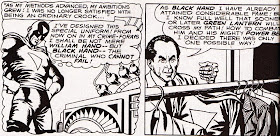Usually, I pride myself on confining myself to discussing the inane (e.g., Dazzler), the irrelevant (Aqualad), and the unpopular (e.g., Vibe). But even I cannot resist the urge to discuss, well, the only thing anyone's discussing:
Blackest Night.
I
should hate it. I mean, really: zombies? [Of course, they're actually revenants, not zombies in the classical voodoo sense, but thanks to all those movies, everyone calls revenants 'zombies' nowadays.]
Yet I do not hate it. I love it. Why?
1. The proper groundwork has been laid. Lordy, the roots of this story are deep within the DCU's history (including elements that I can't mention because they would be spoilers for some inevitable reveals about the Black Lantern). Plus, writers (well, Johns) have built this story brick by brick out of recent year's developments and intentional additions (the death of the Dibnys and many others, the Spectre's punishment of Black Hand, Parallax, the 'emotional color spectrum', the Sinestro War, "Engine City", Xanshi, JLI, the trouble between the Hawks... really, just about everything). This doesn't feel like some external "event'' imposed upon the DCU by editorial fiat that doesn't jibe with anything else. Quite the opposite; it pulls together many loose threads in the DCU and puts them in a overall context that helps it all make more sense and seem more cohesive.
2. The metatextual element. I appreciate when DC takes advantage of an 'event' to do more than simply tell a story.
Legends, for example, made complex points about heroism. Blackest Night is a commentary (criticism?) of comic books' Revolving Door of Death. As longtime readers may remember, I am an admirer of the
Ivory Soap Method of marketing. "Blackest Night" is an astonishingly bold example. DC has said,
"Let's take out two most damning criticisms == that we violently kill off our characters with foolish abandon and that we keep bringing people back from the dead == and make those the central issues in our coolest company-wide story of all time." That's sheer genius.
3. It's not zombies; it's zombies with power rings. Which is, um, totally different. Somehow. It makes you wonder: what side is Driq on?
4. The possibly of fixing, well, almost everything. Ever since 1985, I've been waiting for DC to "fix everything".
Crisis on Infinite Earths was the first time DC told me they were going to give themselves a chance to fix everything that needed fixing. I remember being very excited by the idea that DC would "fix everything" by eliminating everything dumb (which is to say, Things That Didn't Make Me Happy in My Comics) and reorganizing and reemphasizing everthing cool. They didn't, of course. Like any legislative body (such as Congress), DC's editors focused too much on changing the situation they didn't like (accumulated Bronze Age continuity) and too little on the new situation they'd be replacing it with (post-Crisis continuity). They gave themselves another chance during
Zero Hour (but didn't really fix everything). They gave themselves yet another chance with
Infinite Crisis (other than bringing back Barry and Bart Allen, no one has any idea what happened there).
Now, in Blackest Night they have a chance to fix, well, not everything, but almost everything (since most things that "needed fixed" are the pointlessly sensational killings off of characters). I continue to hope that DC will use this opportunity to fix things, much as a battered wife returns to her abusive husband confident that he's sorry, he's changed, and this time it's going to be different. However, this time, I have some evidence on my side: certain things pretty much
have to be fixed. Specifically, the currently-dead status of Bruce Wayne and Arthur Curry.
I'm not going to get into an argument here about whether these characters should remain dead and whether DC heroes are really legacies, blah blah blah, and neither are you. Because, frankly, our chatter doesn't really matter. It's just a fact: Bruce Wayne and Arthur Curry aren't going to remain dead, and anyone who thinks otherwise is just being naive. Superman, Wonder Woman, Green Lantern, Flash, and Green Arrow didn't stay dead and neither will their two colleagues (J'onn Jonnz? Him I'm not so sure about...).
So, some characters are going to come back from the dead as a result of
Blackest Night. That means, in theory, that ANYONE can. Which means, of course...
5. Vibe is comin' back, meng!



 Mothers of Coast City: heed the warning signs of corruption. If your child hangs its clothes with the hangers facing the wrong way, kill it immediately. Society will thank you.
Mothers of Coast City: heed the warning signs of corruption. If your child hangs its clothes with the hangers facing the wrong way, kill it immediately. Society will thank you.





































